Can’t Find What You Are Looking For? Find Out About Our Bespoke Design Solutions. Read More.
IFR + Inherent Anti-UV Fabric
Anti-UV fabric is a type of textile that is designed to block ultraviolet radiation.
It is commonly used in clothing, outdoor furniture, and shade structures to protect people and objects from the harmful effects of UV radiation.
What Is Flame Retardant UV Resistant Fabric?
Flame Retardant UV Resistant Fabric combines advanced UV-blocking technology with permanent flame resistance for superior protection. Designed with specialized yarns and fabric structures, it effectively shields against harmful UV rays, preventing skin damage, sunburn, and premature aging, while also delaying flame spread and reducing smoke emission in fire hazards. Ideal for outdoor workwear, protective clothing, and industrial applications.
UVA, the Killer of Skin Aging
In addition to visible light, the sun’s spectrum also includes invisible ultraviolet and infrared light. Ultraviolet light is an electromagnetic wave with a shorter wavelength than visible light and accounts for about 6% of the spectrum. According to wavelength, ultraviolet radiation can be divided into three types: UVA, UVB, and UVC. Among them, UVA and UVB cause the most harm to the human body.
UVA: It is an invisible killer that can penetrate glass, some clothing, and the epidermis of the skin. It can penetrate the dermal tissue and react with it, gradually destroying the skin’s elasticity, leading to the production of melanin, wrinkles, and sagging. UV radiation is the primary cause of skin aging and tanning.
UVB radiation possesses higher energy levels, enabling it to penetrate the skin’s epidermis, leading to sunburn, redness, swelling, and blisters. Excessive exposure to the sun is the primary cause of sunburn, skin tumors, and immune suppression.
UVC radiation possesses the highest energy and the most potent effect, capable of inducing sunburn, genetic mutations, and tumors. However, it is largely absorbed by the ozone layer before reaching the Earth’s surface, thereby posing no harm to humans.
Only UVA and UVB rays can impact human health. Among them, UVA is the most harmful and potent, leading to tanning, loss of collagen elasticity, wrinkles, and aging. It constitutes approximately 95% of all UV radiation in sunlight. The remaining 5% is UVB, which is the main cause of sunburn. Long-term exposure to UV radiation can also cause textiles to fade and age. Therefore, it is necessary to treat textiles with UV-resistant finishing.
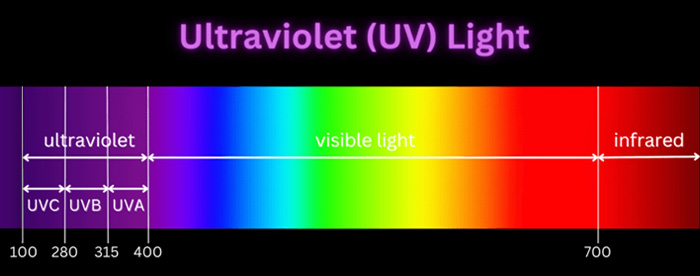
What Is UPF (Ultraviolet Protection Factor)?
UPF is a professional sun protection factor used for textiles, and a higher UPF represents better sun protection ability (the ability to resist UVB and UVA). In typical conditions, a UPF25 sun protection factor is effective in blocking most of the UV radiation. If you expect to be exposed to the sun for an extended period, opt for clothing with a higher sun protection factor.
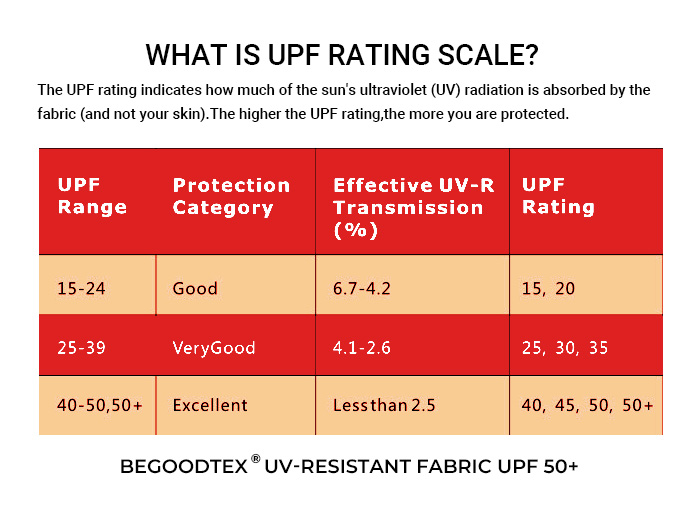
The Mechanism of UV-Resistant Finishing
From an optical perspective, when light is projected onto an object, a portion of it reflects off the surface, some is absorbed by the object, and the rest passes through the object. In general, the sum of transmittance rate, reflectance rate, and absorbance rate equals 100%.
The principle of UV-resistant processing involves using UV blockers to treat fibers or fabrics.
When light radiation reaches the fabric, a small portion passes through the gaps in the fabric, while most of it is reflected or selectively absorbed by the UV blockers. The absorbed light is converted into low energy, which is then released, effectively blocking the UV radiation.
UV-Resistant Textiles Production
The production of UV-resistant textiles belongs to the category of textile post-treatment. It primarily involves the application of UV-resistant finishing agents, the preparation of finishing solutions, and the selection of appropriate finishing processes.
The finishing process of UV-resistant fabrics depends on the type of fabric and its intended use. For example, summer clothing requires high softness and comfort, and it is better to use absorption or impregnation methods for UV-resistant finishing.
When used as decorative, household, or industrial textiles, the focus is on their functional requirements, and surface coating methods can be applied.

Factors Affecting the UV Radiation Resistance of Fabrics
The ability of fabrics to resist UV radiation depends mainly on their capacity to shield against UV radiation. Fabrics typically have intricate surfaces that not only absorb light but also scatter and reflect it.
The effects of scattering and reflection need to consider various factors of the fabric itself, such as fabric structure, original yarn structure, fiber variety and regularity, and fabric color.

1. The Influence of the Structure of UV-Resistant Fabrics
The fabric structure determines the geometric shape of the fabric. The thickness and density (covering coefficient or porosity) of the fabric structure. The tighter the fabric structure, the larger the covering coefficient, and the lower the UV transmittance, the greater the protective effect on the human body. Sparse fabrics have a low covering coefficient and do not effectively block light, resulting in limited protective effects.
2. The Influence of UV-Resistant Fibers and Yarns
Under the same fabric structure, different types of fibers have varying rates of UV transmittance. Polyester and wool fibers have lower UV transmittance rates than cotton and viscose fibers. This is due to the benzene ring in the polyester molecule and the amino acid in protein fibers like wool and silk, which possess strong absorption properties for UV light with wavelengths less than 300nm.
Selection of UV-Resistant Fabrics
From Color Classification:
Dark colors are most effective at absorbing UV rays, making them the best for preventing UV radiation. The darker the color, the higher its UV protection, such as black, navy blue, dark blue, and dark purple.Bright colors, in addition to dark colors, have the ability to absorb UV rays. For instance, bright red, with its longer wavelength, can absorb a significant amount of UV rays from the sun. White can only reflect visible light and cannot effectively block UV rays.
From the Fabric Structure:
Thicker fabrics in different types of clothing are more effective at resisting UV radiation compared to thinner fabrics. Polyester fibers offer the highest UV resistance due to the presence of a benzene ring in their molecular structure, which enables them to absorb UV rays effectively. Nylon, cotton, and silk have low UV resistance. Therefore, when selecting UV-resistant clothing, it is advisable to opt for thicker fabrics that contain polyester fibers.
The tighter the fabric, the stronger the blocking ability, and the less UV radiation can penetrate. Woven fabrics have better UV resistance than knitted fabrics. The darker the color of the clothing fabric, the less UV radiation can penetrate, and the better the UV resistance.
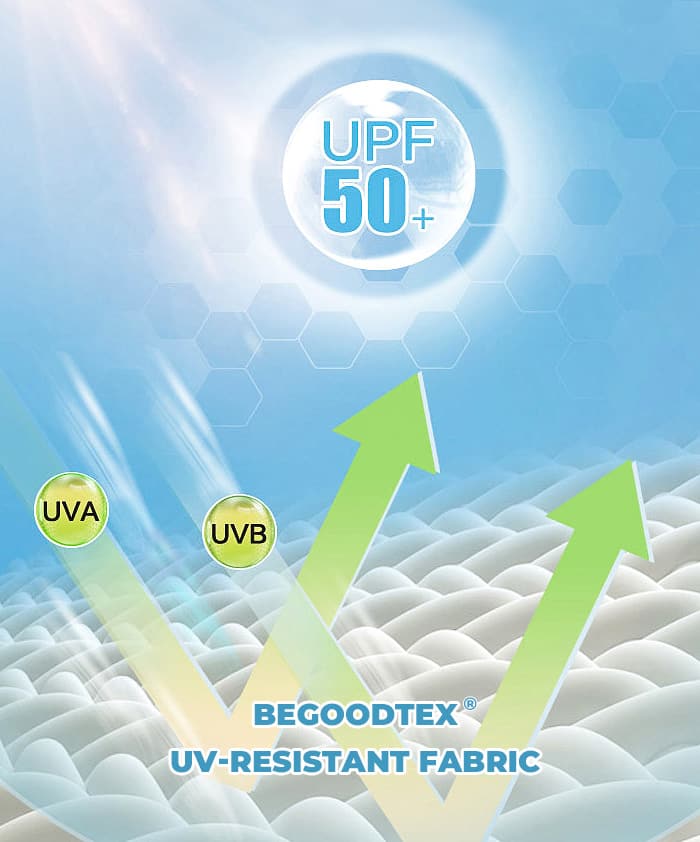
Advantages of BEGOOGDTEX UV-Resistant Fabric
- Good absorption and emission of ultraviolet radiation in the 180-400 nm wavelength range, particularly UV-A and UV-B.
- It has a strong shielding ability with a UV transmittance rate of less than 3%.
- UV resistance remains above 85% after multiple washings.
- Non-toxic, safe for human use with no skin irritation or allergic reactions.
- Good moisture absorption and breathability.
- Can achieve UPF50+ according to customer requirements, offering excellent protection against UV radiation.
- Suitable for outdoor workwear, high-altitude clothing, and sun umbrellas.
- Complies with current domestic and international UV protection performance testing standards.
Indicators for Evaluating UV Resistance Performance
- UV transmittance rate
- UV shielding rate
- Sun Protection Factor (SPF) and Ultraviolet Protection Factor (UPF)
- Penetration rate
- UV reflection rate
- Logarithm of the average transmission rate for A and B wavelength fabrics
Applications Of IFR + Inherent Anti-UV Fabric
- T-shirts, fashion, outdoor clothing, skiwear, student uniforms, skirts and household curtains.
- Swimsuits, sportswear, beachwear, sun skirts, hats that protect ears and necks.
- Men’s summer wear, women’s shirts, skirts, and pants.
- Stockings, scarves, outerwear, tents, sun umbrellas.
- Mountaineering clothing, gloves and sun hats.
Among them, UV-resistant polyester fibers are very suitable for producing all kinds of woven and knitted clothing fabrics, which can be made through pure spinning or interlacing. They are mainly used for processing summer clothing fabrics, sun hats, cool umbrellas, and summer women’s stockings. The weaving performance is good, the fabric style is unique, and the hand feel is comfortable.
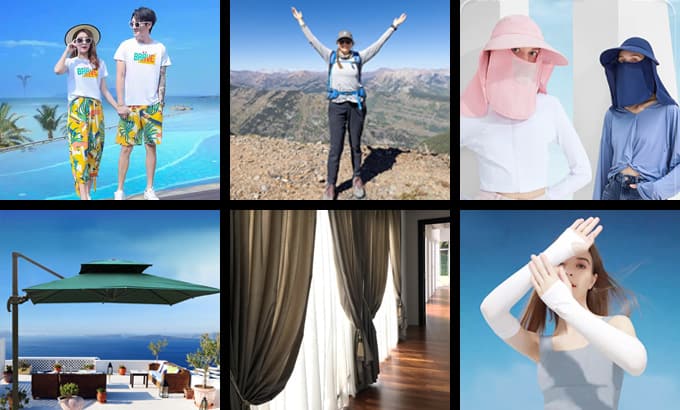
Relative Products
-

ermanent Flame Resistant Blackout Curtains Drape for Living Room, 6 Silver Grommet
BG-HTCT-GR -
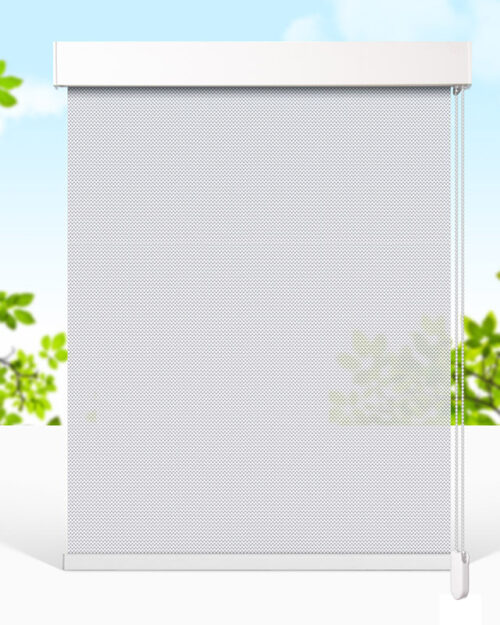
One-Way Perspective Flame-Retardant Thermal Insulation Window Screen Fabric
BG-HTCT-22 -

Fire Resistant Sheer Curtains for Bedroom Living Room
BG-HTCT-21 -

Begoodtex Flame Retardant Composite Coating 100% Blackout Curtains
BG-HTCT-20 -
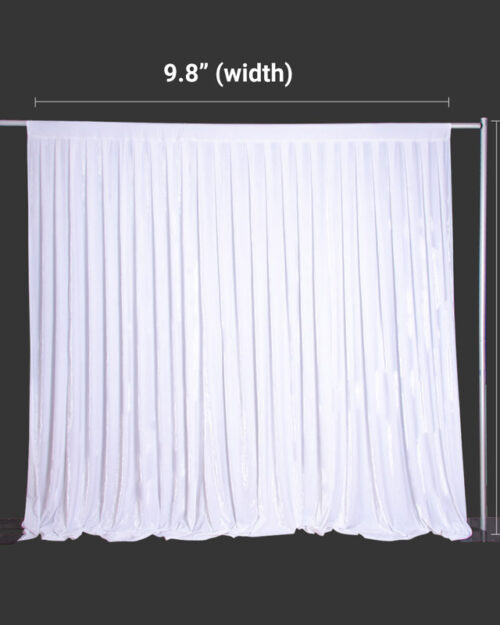
Flame Retardant White Velvet-Like Backdrop Curtain Drapes
BG-EVDP-WT-05 -
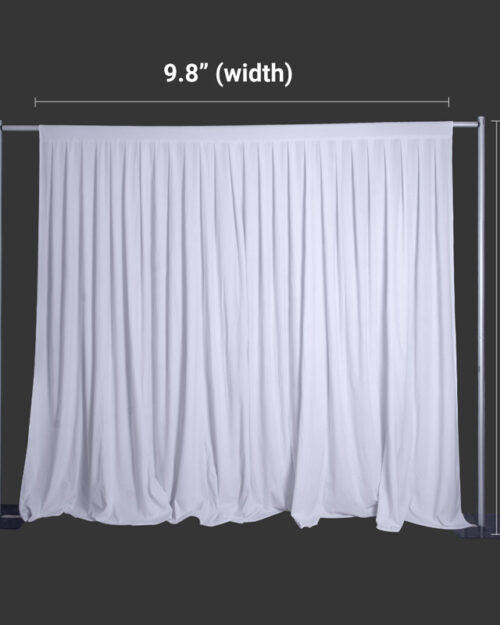
Flame Retardant White Velvet Backdrop Curtain Drapes
BG-EVDP-WT-04 -
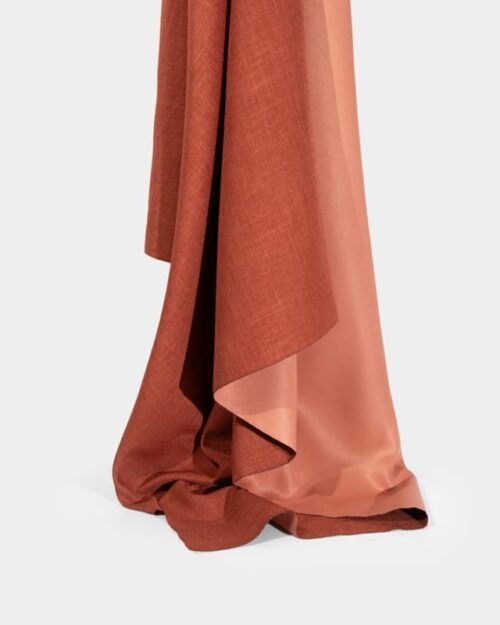 W: 300 cmWt: 320 g/m²
W: 300 cmWt: 320 g/m²Fire Retardant Faux Linen Blackout Fabric Polyester, 300cm Width
#0101 Black#0203 Beige#0302 Gray#0401 Light Brown#0403 Dark Brown#0703 Dark Orange#0902 Green#1001 Light Cyan#1103 Dark Blue+4 MoreBG-C11 -
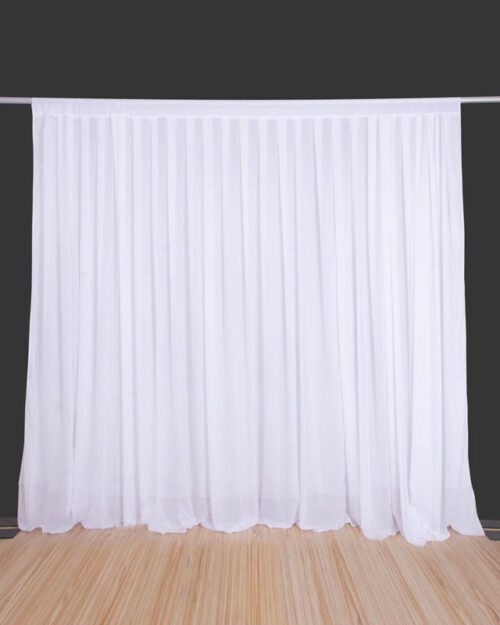
Flame Retardant Chiffon Backdrop Curtains for Wedding Decoration
BG-EVDP-WT-03 -
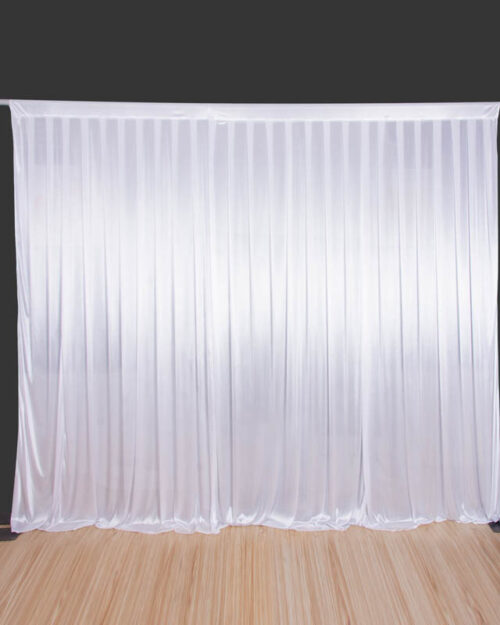
Flame Retardant White Satin Backdrop Curtain for Events Decoration
BG-EVDP-WT-02 -
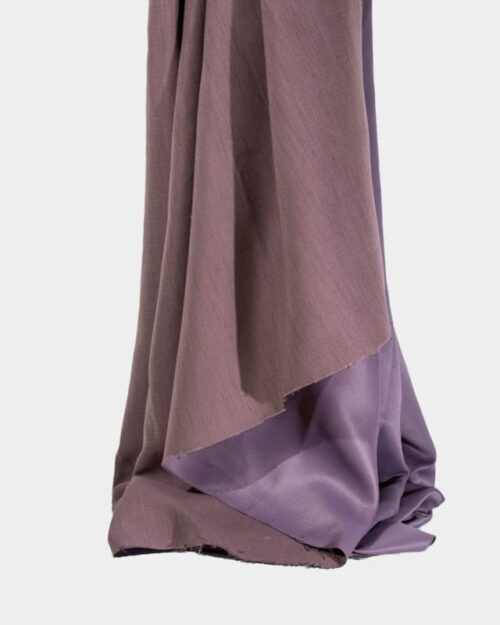 W: 300 cmWt: 350 g/m²
W: 300 cmWt: 350 g/m²Flame Retardant Faux Linen Blackout Fabric for Curtain, 300cm Width
#0201 White#0202 Off-White#0202-1 Snow#0202-2 Ghost White#0203 Beige#0203-1 Ivory#0301 Light Gray#0302 Gray#0303 DarkGray#0401 Light Brown#0402 Brown#0403 Dark Brown#0701 Light Orange#0702 Orange#0901 Light Green#1101 Light Blue#1202 Purple+12 MoreBG-C4
